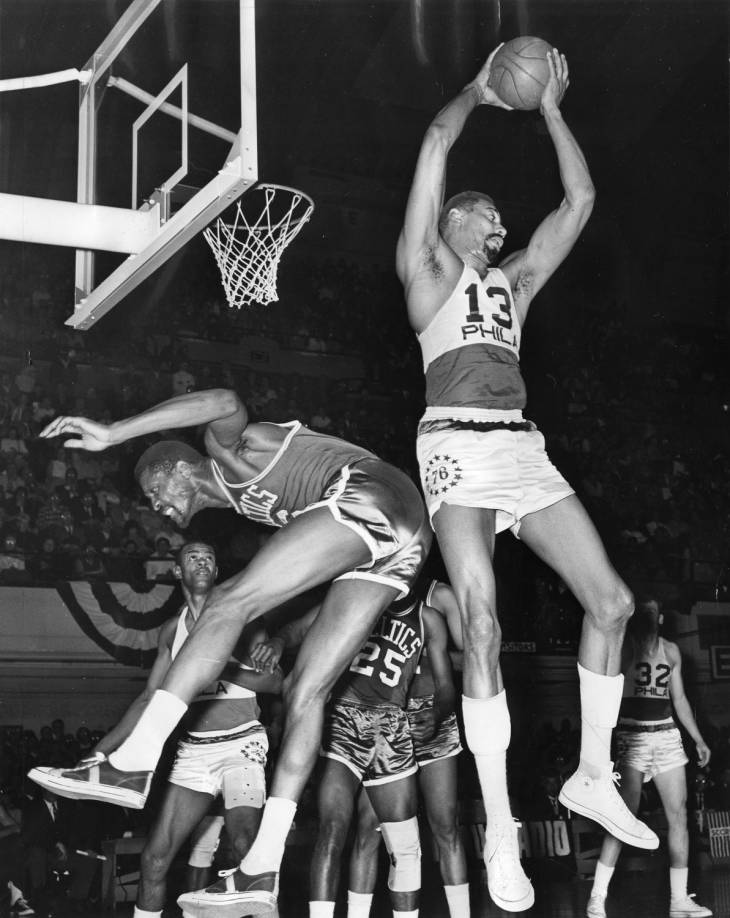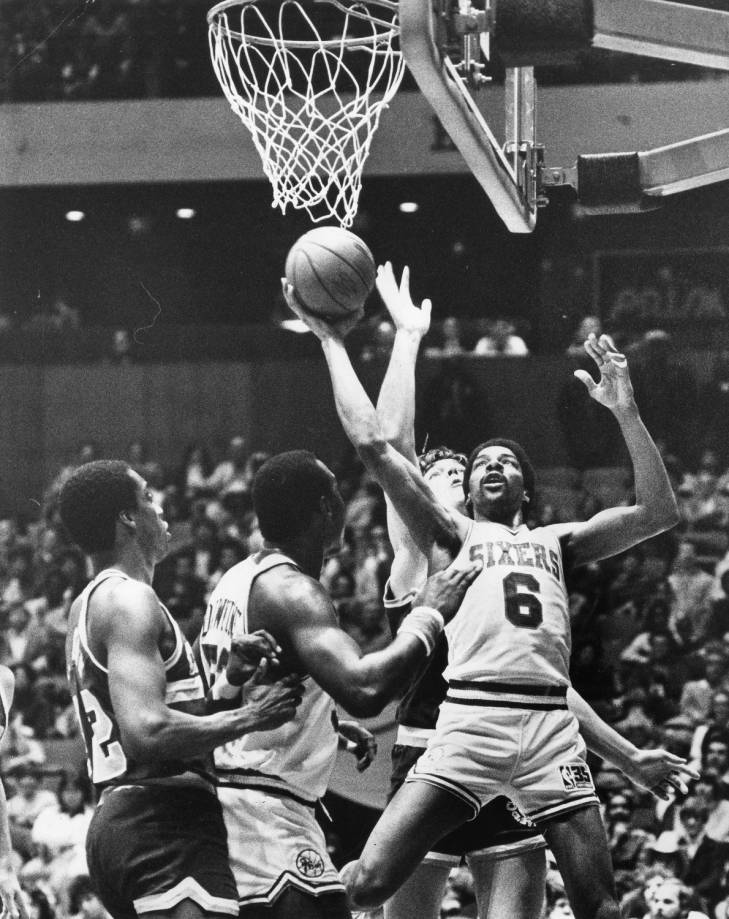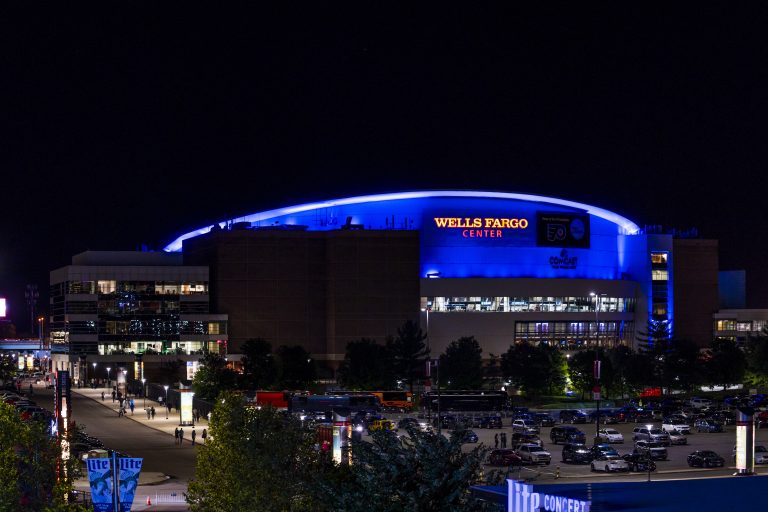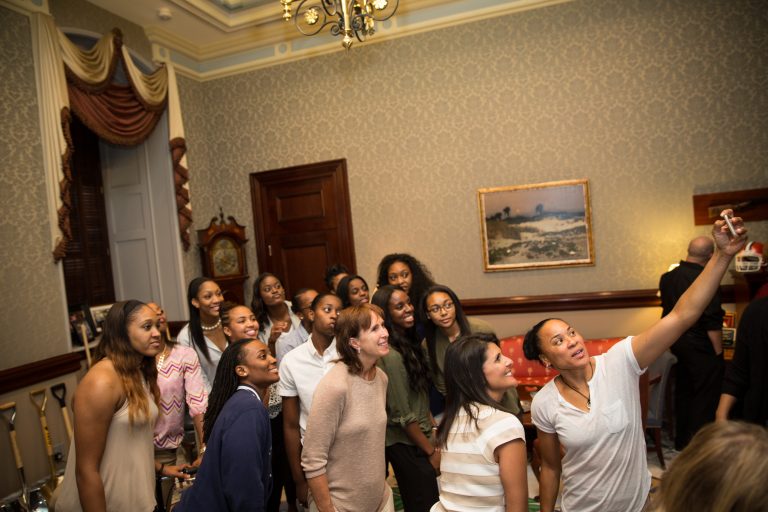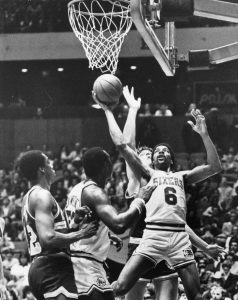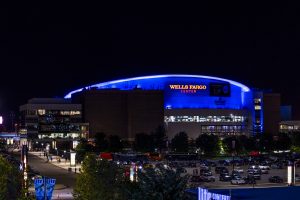Basketball (Professional)
Essay
Professional basketball has a long history in the Philadelphia region, from the first professional league, formed in 1898, to the National Basketball Association (NBA). The city produced memorable teams, including the Warriors and 76ers, and Hall of Fame players such as Wilt Chamberlain (1936-99) and Dawn Staley (b. 1970). Philadelphia teams and players from the Philadelphia region contributed to the success of professional basketball in the region and beyond.
Basketball dates to 1891, when James Naismith (1861-1939) invented the game at the YMCA in Springfield, Mass., as an indoor activity for the winter months. The sport incorporated elements of rugby, lacrosse, and soccer: passing, the jump ball, shooting toward a goal, and the shape and size of the ball. Naismith nailed two peach baskets to the lower rail of the balcony in the gymnasium and drafted rules for the new game. Basketball quickly became a popular winter sport, and by the end of the decade professional leagues formed in New Jersey, New York, and Pennsylvania.
Professional basketball in Philadelphia began in August 1898, when the sports editor of the Philadelphia Public Ledger, Horace Fogel (1861-1928), organized the National Basketball League with three teams from the Philadelphia and three from South Jersey. In this era, a twelve-foot chain link cage ringed the court to separate players from fans, but the cage mainly led to hockey-style body checks and fans sticking pins and lit cigars into the players’ flesh. (Rope replaced the iron cages in the 1920s.) Players from the Philadelphia region competed on teams that included the Clover Wheelmen (also known as the Pennsylvania Bicycle Club), Germantown Nationals, and Hancock Athletic Association, but none of the Philadelphia-based teams won a title before the National Basketball League folded in January 1904.
Early Game Venues
During the early years, games took place in local armories and fraternal halls, and most players gained experience with the game by playing for fraternal organizations or athletic clubs. Squads representing fraternal organizations such as the Elks and Moose also played in professional leagues of the early twentieth century: the Philadelphia Basketball League (1902-09, revived 1923-28), the Eastern Basketball League (1909-17 and 1919-20, revived 1929-36), and the American Basketball League (1918-19, revived 1926-28 and 1933-49).
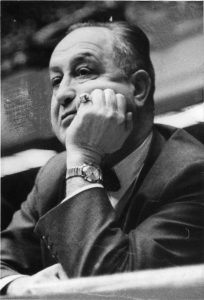
During the first half of the twentieth century, the Philadelphia SPHAS—named for the team’s original owner, the South Philadelphia Hebrew Association—reigned as the region’s top team. Owner Eddie Gottlieb (1898-1979) founded the team with sporting goods magnate Harry Passon (1897-1954) and schoolmate Edwin “Hughie” Black (1897-1986). The majority of the team’s players were Jewish, and enthusiastic fans jammed the ballroom of the Broadwood Hotel on North Broad Street on Saturday nights to watch them play. The team won eleven championships while playing in a series of leagues between 1930 and 1945, but after a change in ownership in 1950 became one of three touring opponents of the Harlem Globetrotters.
Some of the SPHAS’ top players joined the region’s next professional basketball team: the Philadelphia Warriors, formed when Philadelphia received a franchise in the new Basketball Association of America (BAA) following World War II. Eddie Gottlieb (by this time no longer active with the SPHAS) became coach and general manager of the Warriors, whose players also included athletes from the University of Pennsylvania, St. Joseph’s College, and Temple University. Playing in the Philadelphia Arena at Forty-Fifth and Market Streets, the Warriors attracted crowds of more than eight thousand fans as they won the inaugural league title following the 1946-47 season. After three seasons, the Warriors became a team in the National Basketball Association (NBA), which formed from a merger of the BAA and the National Basketball League. Splitting home games between the Philadelphia Arena and the higher-capacity Civic Center beginning in 1952, the Warriors won the league championship again in 1955-56 with a roster including homegrown players from LaSalle, Penn, and Villanova.
Enter Wilt Chamberlain
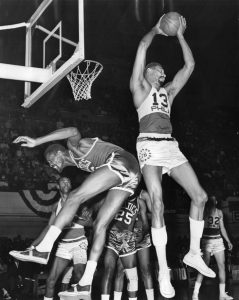
A new star player came to the Warriors in the 1959-60 season. Seven–foot Overbrook High School graduate Wilt Chamberlain (1936-99), who also played for the University of Kansas and the Harlem Globetrotters, led the NBA in scoring and rebounds on the way to winning Rookie of the Year and Most Valuable Player honors. In March 1962, in a game against the New York Knicks played at Hershey Sports Arena to expand the Warriors’ fan base, Chamberlain scored 100 points. Remarkably, given Chamberlain’s record as a notoriously bad free throw shooter, he went 28-32 in the game while playing all forty-eight minutes. In Philadelphia and with other teams, Chamberlain ultimately played sixteen seasons in the NBA.
Following the 1961-62 season, Gottlieb sold the Warriors to a group from San Francisco led by Franklin Mieuli (1920-2010), a radio and television producer. However, the NBA returned to Philadelphia in 1963-64 when investors Irv Kosloff (1912-95) and Ike Richman (1913-65) purchased and relocated the Syracuse Nationals. Renamed the 76ers (or Sixers), the team did not fare well in its first season. The next season, the team acquired Wilt Chamberlain from the Warriors, but it took two more seasons for the Sixers to achieve greatness. During 1966-67, Chamberlain led the 76ers to a 68-13 record and their first NBA championship. After the next season—the first season of play in the new, 15,000-seat Spectrum arena in South Philadelphia—the Sixers acceded to Chamberlain’s desire to play on the West Coast and traded him to the Los Angeles Lakers. The trade began a decline that reached its nadir in 1972-73, when the Sixers compiled a 9-73 record, the worst in NBA history.
The Sixers found a winning path again after acquiring American Basketball Association star Julius Erving (Dr. J) (b. 1950) before the 1976-77 season. As new owner Fitz Eugene Dixon Jr. (1923-2006) increasingly invested in talent, the team reached the finals following the 1976-77, 1979-80, and 1980-81 seasons. Harold Katz (b. 1936), who bought the Sixers in 1981, continued improving the team. Then, after acquiring Moses Malone (1955-2015) from the Houston Rockets before the 1982-83 season, the Sixers swept the Lakers and won the championship. In later years, the Sixers reached the playoffs eighteen times and the NBA finals once. Comcast Spectacor bought the Sixers from Katz in 1996 and expanded the potential attendance for Sixers games to 21,000 with the opening of the CoreStates Center (later renamed First Union, Wachovia, and then Wells Fargo Center). Ownership changed again in 2011 when an investment group led by New York billionaire Joshua Harris (b. 1965) and actor/singer Will Smith (b. 1968), a Philadelphia native, purchased the team. Key players during the post-Erving era included power forward Charles Barkley (b. 1963), point guard Allen Iverson (b. 1975), and swingman Andre Iguodala (b. 1984), who later earned most valuable player honors in the 2015 NBA finals while playing with the Golden State Warriors. In 2019, the Sixers made it to the playoffs but lost to eventual NBA champion Toronto Raptors on a last-second shot in the seventh game.
Women’s Basketball
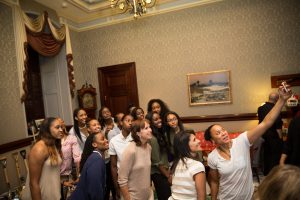
Women’s professional basketball came to Philadelphia in 1979, during the second season of the first women’s professional league, the short-lived Women’s Professional Basketball League. The Philadelphia Fox played just ten games in November and December 1979, winning two and losing eight, before financial difficulties and ownership disputes ended the team. Nearly two decades passed before the 1996 gold-medal performance of the U.S. women’s basketball team at the Olympics ushered in a new generation of women’s professional leagues—the Women’s National Basketball League (WNBA) created by the NBA and the American Basketball League (ABL). Philadelphia gained a women’s team once again when the Rage, formerly based in Richmond, Virginia, moved before the 1997-98 season. With the Rage came team leader Dawn Staley (b. 1970), a Philadelphia native who had been a standout player for Dobbins Technical High School, the University of Virginia, and the U.S. Olympic team. Despite Staley’s star power and a home court at the University of Pennsylvania’s Palestra, the Rage attracted lower than expected attendance and compiled a losing season of 13 wins against 31 loses. Staley left for the WNBA, and by December 1998 the bankruptcy of the ABL also brought an end to the Rage.
Women also played a role in coaching and management. Although Philadelphia has never had a WNBA franchise, in 2019 Collingswood, New Jersey, native and former Lehigh University player Cathy Engelbert (b. c. 1965) became commissioner of the league. Former WNBA player Lindsey Harding (b. 1984) in 2019 served briefly as an assistant coach for the 76ers before leaving to coach for the Sacramento Kings. A developmental professional women’s team also began play in Philadelphia in 2019 with a goal of growing into a WNBA franchise. The Reign, of the Women’s Basketball Development Association, played home games at Chestnut Hill College during the 2019 season.
Beyond Philadelphia
Professional basketball players from the Philadelphia area made their mark elsewhere in the NBA and other leagues. A player from Villanova, Paul Arizin (1928-2006), became the league’s first great scorer and one of the top NBA players of all time. Earl Monroe (b. 1944), who played college basketball at Winston-Salem State University in North Carolina, helped the New York Knicks win the NBA title in 1973. Rasheed Wallace (b. 1974), who played at the University of North Carolina, led the Detroit Pistons to the NBA title in 2004. Joe Bryant (b. 1954) of LaSalle played eight seasons from the Sixers, San Diego Clippers, and Houston Rockets, and his son Kobe Bryant (1978-2020) went straight from Lower Merion High School to the Los Angeles Lakers and led them to five NBA championships. Louis “Red” Klotz (1920-2004), who started with the Philadelphia SPHAS, later formed the teams that played the Harlem Globetrotters. Dawn Staley, in addition to her play in the ABL and WNBA for more than a decade, was a three-time Olympic gold medalist and coached at Temple University, the University of South Carolina, and the women’s national basketball team. Adding to a professional basketball heritage extending over 120 years, these Philadelphia–area basketball players contributed to the success of Philadelphia teams and others in professional leagues.
Karen Guenther is Professor of History at Mansfield University and author of Sports in Pennsylvania, published by the Pennsylvania Historical Association. (Author information current at time of publication.)
Copyright 2020, Rutgers University
Gallery
Backgrounders
Connecting Headlines with History
Links
- Wilt Chamberlain's Scoring Record Historical Marker (ExplorePAHistory.com)
- Philadelphia SPHAS (Vimeo.com)
- National Basketball League (All About Basketball)
- Philadelphia 76ers History (NBA.com)
- When the Warriors were from Philadelphia (BillyPenn)
- The Peak Years of the Philadelphia Arena (West Philadelphia Collaborative History)
